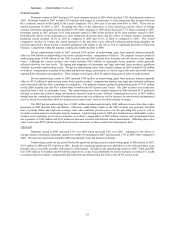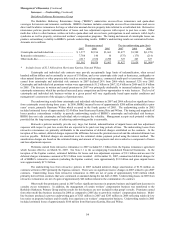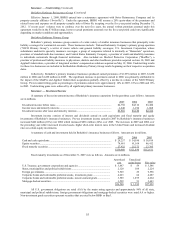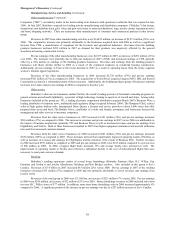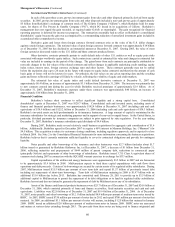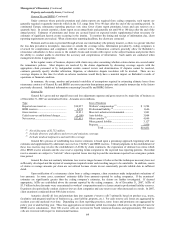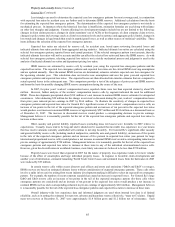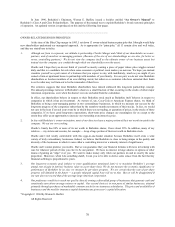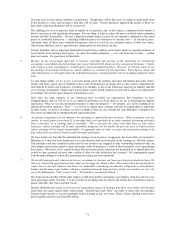Berkshire Hathaway 2007 Annual Report Download - page 64
Download and view the complete annual report
Please find page 64 of the 2007 Berkshire Hathaway annual report below. You can navigate through the pages in the report by either clicking on the pages listed below, or by using the keyword search tool below to find specific information within the annual report.
63
Property and casualty losses (Continued)
GEICO (Continued)
For unreported claims, IBNR reserve estimates are calculated by first projecting the ultimate number of claims
expected (reported and unreported) for each significant coverage by using historical quarterly and monthly claim counts to
develop age-to-age projections of the ultimate counts by accident quarter. Reported claims are subtracted from the ultimate
claim projections to produce an estimate of the number of unreported claims. The number of unreported claims is multiplied by
an estimate of the average cost per unreported claim to produce the IBNR reserve amount. Actuarial techniques are difficult to
apply reliably in certain situations, such as to new legal precedents, class action suits or recent catastrophes. Consequently,
supplemental IBNR reserves for these types of events may be established through the collaborative effort of actuarial, claims and
other management.
For each of its major coverages, GEICO tests the adequacy of the total loss reserves using one or more actuarial
projections based on claim closure models, paid loss triangles and incurred loss triangles. Each type of projection analyzes loss
occurrence data for claims occurring in a given period and projects the ultimate cost.
In 2007, claim frequencies were generally lower than expected and severity increases were generally not as great as
originally projected during the first part of the year. Loss reserve estimates recorded at the end of 2006 developed downward by
approximately $375 million when reevaluated at December 31, 2007 producing a corresponding increase to pre-tax earnings in
2007. These downward reserve developments represented approximately 3% of earned premiums in 2007 and approximately 6%
of the prior year-end reserve amount. Reserving assumptions at December 31, 2007 were modified appropriately to reflect the
most recent frequency and severity results. Future reserve development will depend on whether frequency and severity turn out
to be more or less than anticipated. Within the automobile line of business the reserves with the most uncertainty are for
automobile liability, due to the longer claim-tails for most of these coverages. Approximately 90% of GEICO’ s reserves as of
December 31, 2007 were for automobile liability, of which bodily injury (“BI”) coverage accounted for nearly 60%.
Management believes it is reasonably possible that the average BI severity will change by at least one percentage point from the
severity used. If actual BI severity changes one percentage point from what was used in establishing the reserves, the reserves
would develop up or down by approximately $99 million resulting in a corresponding decrease or increase in pre-tax earnings.
Many of the same economic forces that would likely cause BI severity to be different from expected would likely also cause
severities for other injury coverages to differ in the same direction.
GEICO’ s exposure to highly uncertain losses is believed to be limited to certain commercial excess umbrella policies
written during a period from 1981 to 1984. Remaining reserves associated with such exposure are currently a relatively
insignificant component of GEICO’ s total reserves (less than 3%) and there is little apparent asbestos or environmental liability
exposure. Related claim activity over the past year was insignificant.
General Re and BHRG
General Re’ s and BHRG’ s property and casualty loss reserves derive primarily from assumed reinsurance. Additional
uncertainties unique to loss reserving processes for reinsurance are described below. The nature, extent, timing and perceived
reliability of information received from ceding companies varies widely depending on the type of coverage, the contractual
reporting terms (which are affected by market conditions and practices) and other factors. Due to the lack of standardization of
the terms and conditions of reinsurance contracts, the wide variability of coverage needs of individual clients and the tendency
for those needs to change rapidly in response to market conditions, the ongoing economic impact of such uncertainties, in and of
themselves, cannot be reliably measured.
The nature and extent of loss information provided under many facultative, per occurrence excess contracts or
retroactive contracts where company personnel either work closely with the ceding company in settling individual claims or
manage the claims themselves may not differ significantly from the information received under a primary insurance contract.
Loss information from aggregate excess of loss contracts, including catastrophe losses and quota-share treaties, is often less
detailed. Occasionally such information is reported in summary format rather than on an individual claim basis. Loss data is
provided through periodic reports and may include the amount of ceded losses paid where reimbursement is sought as well as
case loss reserve estimates. Ceding companies infrequently provide IBNR estimates to reinsurers.
Each of Berkshire’ s reinsurance businesses has established practices to identify and gather needed information from
clients. These practices include, for example, comparison of expected premiums to reported premiums to help identify
delinquent client periodic reports and claim reviews to facilitate loss reporting and identify inaccurate or incomplete claim
reporting. These practices are periodically evaluated and changed as conditions, risk factors and unanticipated areas of
exposures are identified.
The timing of claim reporting to reinsurers is delayed in comparison with primary insurance. In some instances there
are multiple reinsurers assuming and ceding parts of an underlying risk causing multiple contractual intermediaries between
General Re or BHRG and the primary insured. In these instances, the delays in reporting can be compounded. The relative
impact of reporting delays on the reinsurer varies depending on the type of coverage, contractual reporting terms and other
factors. Contracts covering casualty losses on a per occurrence excess basis may experience longer delays in reporting due to the
length of the claim-tail as regards to the underlying claim. In addition, ceding companies may not report claims to the reinsurer
until they believe it is reasonably possible that the reinsurer will be affected, usually determined as a function of its estimate of
the claim amount as a percentage of the reinsurance contract retention. On the other hand, the timing of reporting large per
occurrence excess property losses or property catastrophe losses may not vary significantly from primary insurance.


